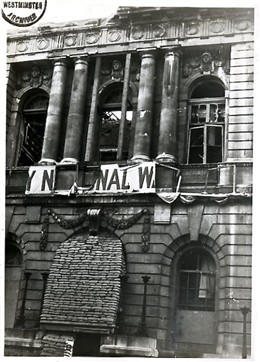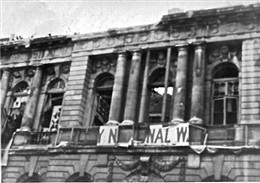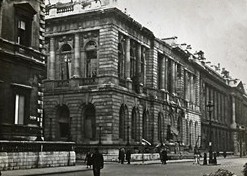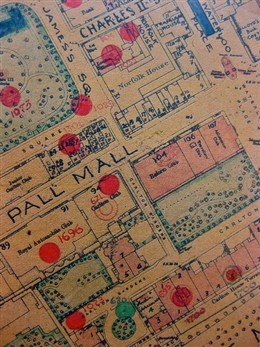Carlton Club, Pall Mall

Carlton Club from Pall Mall, 15 October 1940
Copyright Westminster City Archives

Carlton Club from Pall Mall, 15 October 1940
Copyright Westminster City Archives

Carlton Club from Pall Mall, 15 October 1940
City of Westminster Archives

Bomb Map: Carlton Club, Pall Mall, 14 October 1940
Copyright Westminster City Archives
Former Carlton Club, 100 Pall Mall
14 October 1940
By Brittni Morris
The Carlton Club, built in 1835 at 100 Pall Mall SW1, was one of many political clubs in London for the upper-middle class and aristocracy. At 7.48pm on 14 October 1940, the Carlton (affiliated to the Conservative Party) was struck by a single high explosive bomb, which crashed through the roof and exploded in the Library.
Approximately half of the British War Cabinet - including the future Conservative Prime Minister Harold Macmillan - were dining in the Club at the time, one floor below. Badly shaken, they all escaped injury. But two other fatalities were recorded, including a soldier killed by an lamp post blown along Pall Mall. A car parked outside the Club was also pulverised by falling masonry.
In his war diaries, General (later Field Marshal) Alanbrooke (Commander-in-Chief Home Forces) recorded his impressions that night:
'Left office at 8pm in middle of heavy air raid with sky lit up by flares. Arrived outside (Army and Navy) Club to find the whole street littered with glass and car unable to drive down Pall Mall. The Carlton Club has been hit by a bomb and set on fire ! It is burning hard now and the room here is thick with smoke from it. There are several fire engines working and they seem to be getting it under control. The Germans have been very active in these parts tonight and have dropped many bombs in the vicinity. The moon is unfortunately too bright! ' (Field Marshal Lord Alanbrooke, diary entry 14 October 1940, War Diaries 1939-1945, 1957).
Carlton Club Member Clive Morrison-Bell also wrote an account of the bombing.
Morrison-Bell described the deafening sound as the bomb penetrated the Library. As the bomb exploded, it created a waterfall effect, as parts of the roof fell in and the roaring fire in the fireplace was ripped from the wall, scattering burning coals everywhere. These two particular scenes made the Members inside believe that there were two bombs, though investigators reported only one.
Following the bomb strike, darkness enveloped the Club, along with a covering of thick black smoke that gave off a bitter, acidic taste. Members started calling out to each other in the pitch black darkness. Roof debris continued to fall. Mr Morrison-Bell managed to escape along with other Members. He recounted the confusion and terror of trying to get out of the burning building:
“So slowly towards the door, and out into the hall, the little party moved, now all close together. What about that gallery? Has it come down, or is it going to? What about the stairs, are they still there? The feeble light [from the torch] hardly showed anything, but the stairs were as a matter of fact still there, even if the balustrading had gone, and slowly the little group felt its way down towards the front door… At the foot of the stairs a large heavy door was on the floor, and had to be picked up and laid on one side before the street was finally reached, where the first thing to be seen were about twenty incendiary bombs spluttering away all around.”
There are accounts of these bombs littering Pal Mall and of passers-by kicking them into gutters and putting them out with earth. The sheer scale of destruction at the Carlton Club was not fully appreciated until the next morning. Morrison-Bell noted the massive piles of debris in the street. Members of the destroyed Carlton were soon accommodated by other clubs. These were more than willing to let them in in their time of need.
After the raid the Club relocated to new premises at 69 St James's Street, formally reopening in 1943. In 1958-1959 the Club's former Pall Mall address was completely redeveloped as 100 Pall Mall.